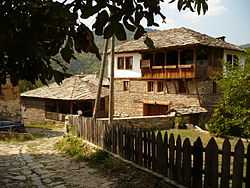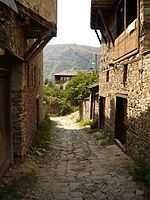Kovachevitsa
| Kovachevitsa Ковачевица | |
|---|---|
| Village | |
 | |
 Kovachevitsa | |
| Coordinates: 41°41′N 23°50′E / 41.683°N 23.833°E | |
| Country |
|
| Province | Blagoevgrad Province |
| Municipality | Garmen |
| Government | |
| • Suffragan Mayor | Stoika Dishlyanova |
| Area | |
| • Total | 117,06 km2 (4,520 sq mi) |
| Population (15-12-2011 [1]) | |
| • Total | 35 |
| GRAO | |
| Time zone | EET (UTC+2) |
| • Summer (DST) | EEST (UTC+3) |
| Postal Code | 2969 |
| Area code(s) | 07527 |
| Website | http://kovachevica.com/en/ |
Kovachevitsa is a village in Garmen Municipality, in Blagoevgrad Province, Bulgaria.
Geography
The village is situated in the Dabrash part of the Rhodope Mountains in the steep valley of Kanina river, 9 kilometers north of Garmen, 71 kilometers southeast of Blagoevgrad and 119 kilometers southeast of Sofia.
History
The village has been founded by refugees from different villages, who tried to escape the Ottoman assimilation in the 17th century. The isolated location and the fresh water supply were the most important factors in this process. The village has never had Ottoman administration, therefore it preserved the Bulgarian traditions.
The church "St. Nicolas" (Bulgarian: Свети Никола, Sveti Nickola) was built in 1847 and a bell-tower was built in 1900. The church is pronounced as national monument of culture.

The first school was founded in 1820 and run by priests. In 1854 was founded a secular school. The school moved to a new two-story house in 1888. Nowadays the school is not working, because the lack of children and the building is preserved as a museum.
Architecture

The architecture of the houses is original and unique. Most of them were built in the second half of the 19th century, but there are also new houses, built in the same style. The village was pronounced "Architectural and Historical Reserve of National Importance" in 1977. Many Bulgarian movies has been filmed there.
Population
The population in the end of the 15th and the beginning of the 16th centuries was 17 persons.[2] In 1873 the population was 630.[3] In 1905 year there were 1740 inhabitants, most of them Bulgarian.[4] Since the middle of the 20th century the population has decreased very quickly. Most of the inhabitants went to the bigger towns and cities. Many of the houses were abandoned and began to self-demolish. After the village was re-found by the Bulgarian cinematography and the new status of the village as a National reserve many houses were rehabilitated and even new houses were built, but in the same architectural style. Now the village has only about 30 constant inhabitants, but actually a lot more live in the Summer and during the vacations and holidays.
Tourism
There are many guest-houses and restaurants in traditional style. The village itself is not the only place of interest. There are many natural sites in the Rhodopes and in the valley of Kanina river. Tourists can visit Leshten – another historical village in the area and the Natural reserve "Temnata gora" and many other places in the Garmen Municipality.
References
| Wikimedia Commons has media related to Kovachevitsa. |
- ↑
- ↑ Гандев, Христо (1989) [1972]. "Населени места с регистрирани имена на главите на домакинствата (XV-XVI в.)". Българската народност през XV век: Демографско и етнографско изследване (II издание ed.). София: Наука и Изкуство.
- ↑ "Македония и Одринско. Статистика на населението от 1873 г." Македонски научен институт, София, 1995, стр.128-129.
- ↑ Brancoff, D.M. "La Macédoine et sa Population Chrétienne". Paris, 1905, pp. 112-113.
| ||||||||||||||||||||
Coordinates: 41°41′N 23°50′E / 41.683°N 23.833°E
